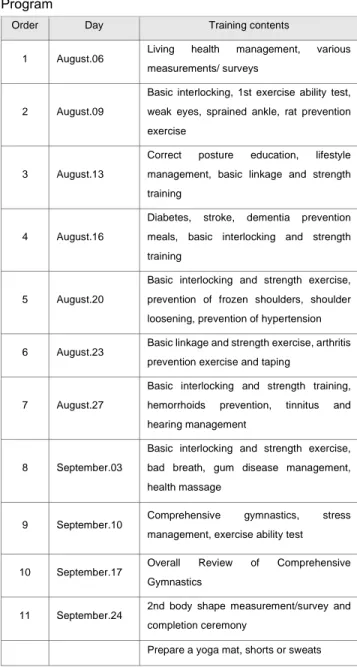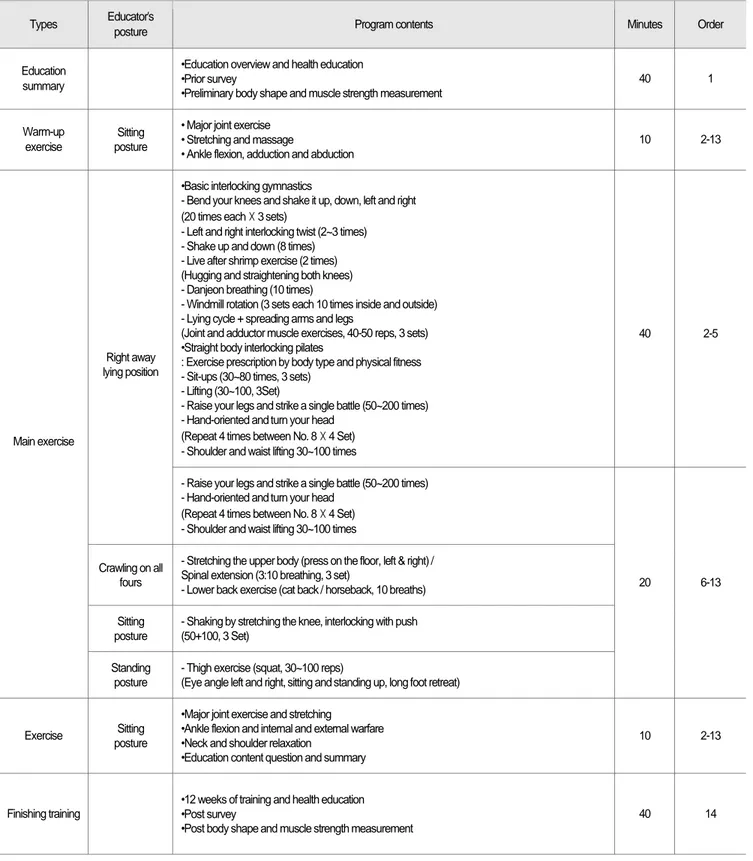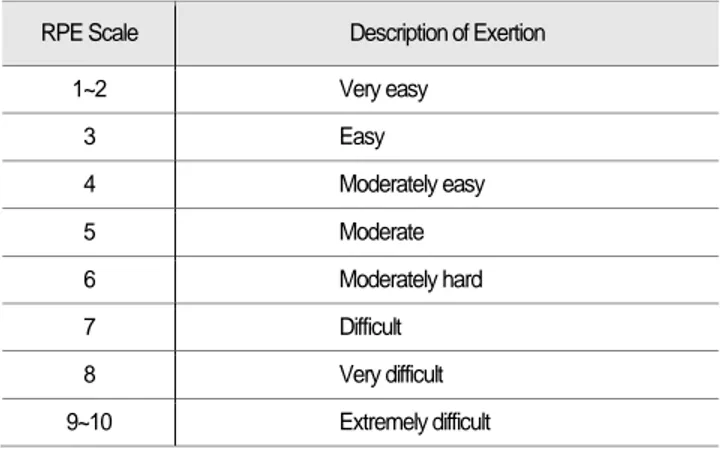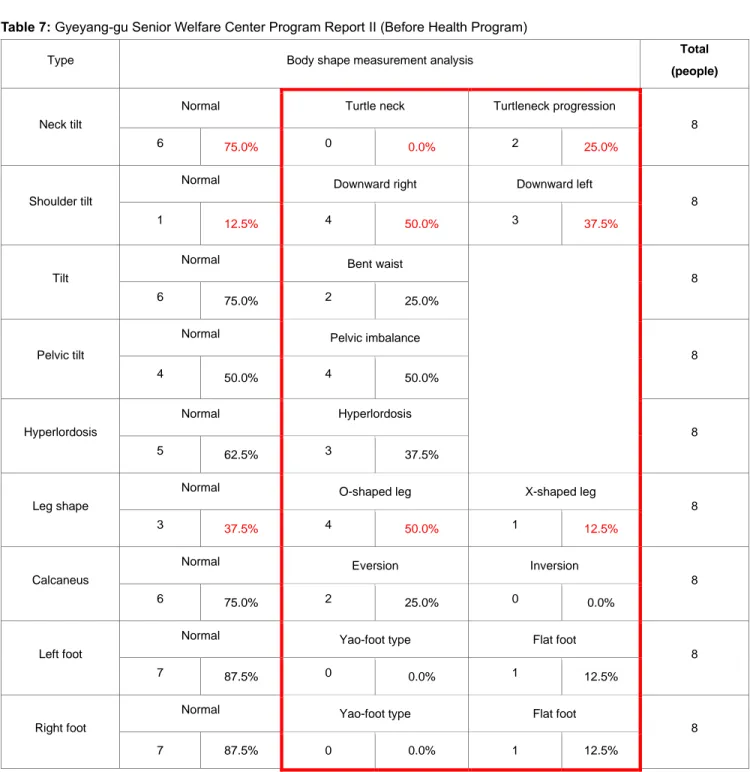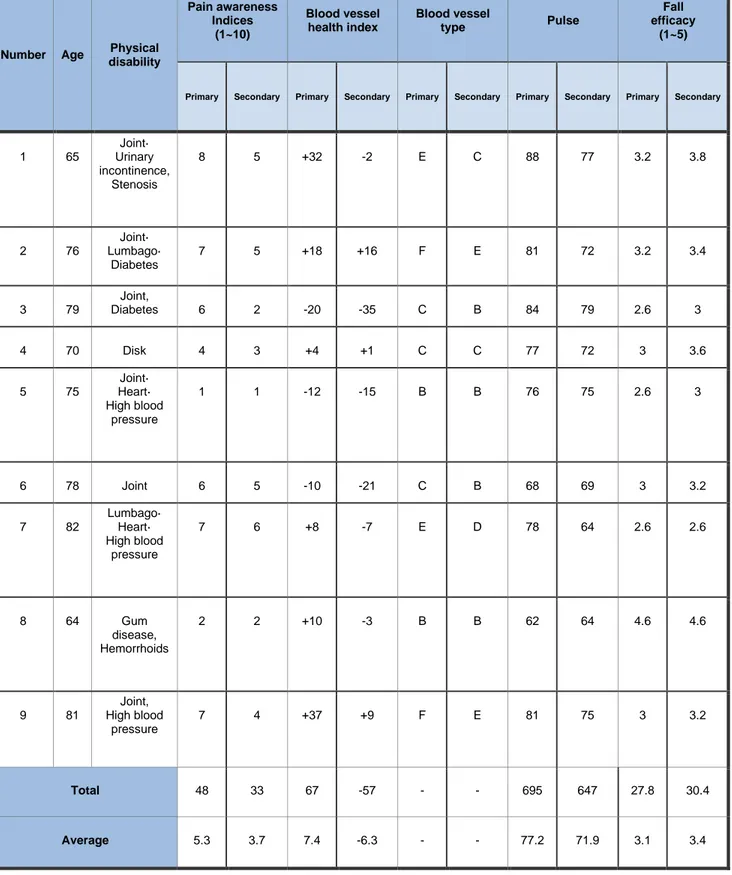27
Physical Recovery through Health Management Education for the
Disabled or the Elderly
Byung-Kook SON
1, Eun-Mee CHOI
2, Lee-Seung KWON
31. First Author Director, Good Posture Research Center, Korea, Email: bioplus21@naver.com
2. Second Author Professor, Dep. of Health Care Management, Catholic Kwandong University, Korea,
Email: smart609@cku.ac.kr
3. Corresponding Author Professor, Dep. of Health Care Management, Catholic Kwandong University, Korea,
Email: leokwon1@cku.ac.kr
Received: March 22, 2021. Revised: March 26, 2021. Accepted: March 29, 2021.
Abstract
Purpose: The number of people with disabilities and the elderly over 65 years of age is gradually increasing due to physical disabilities and social aging. Their typical physical disorders or chronic diseases include low back pain, sciatic pain, arthritis, and musculoskeletal systems such as discs. The average prevalence of disease is 78%. These are various physical obstacles and hindrances in daily life. Research design, data and methodology: From August 6, 2019 to September 24, 2019, the Senior Welfare Center in Gyeyang-gu, Incheon, operated a healthy body exercise and health education program for living health management. Results: The vascular health index using U-Bio pulse wave was relatively good at the first average of +7.4, but the second average of –6.3. This can be seen as a result of the combination of diet and lifestyle education along with the effect of corrective exercise. As a result of body shape measurement analysis, the number of persons requiring management with 3 or more body imbalances was found to be from 75% before to 62.5% afterwards. Conclusions: Exercise effect appears when exercise lasts for at least 10 weeks. Some performances were good, but there were limitations due to the operation of a short training period.
Keywords : Disabled and elderly disability, Physically disabled, Health education, Health program, Physical recovery
JEL Classification Code : II0, I00, I12, I18
1. Introduction
1The number of people with disabilities and the elderly over 65 years of age is gradually increasing due to physical disabilities and social aging (Taaffe, 2006; Borg, 1985). Their typical physical disorders or chronic diseases include low back pain, sciatic pain, arthritis, and musculoskeletal systems such as discs. The average prevalence of disease is 78%. These are various physical obstacles and hindrances in
ⓒ Copyright: The Author(s)
This is an Open Access article distributed under the terms of the Creative Commons Attribution Non-Commercial License (http://Creativecommons.org/licenses/by-nc/4.0/)
daily life (Lee at al., 2011; Buchmann et al., 2010; Jang, 2009). Efforts are required to minimize physical difficulties or discomfort to the disabled or the elderly in the area (Cummings, et al., 1993; Lim et al., 2015; Son, 2007). To this end, it is necessary to cultivate self-health management ability for chronic diseases as well as preventing musculoskeletal diseases, which are practically inconvenient and hindered. A program that combines life and health management guidance and exercise that can contribute to health promotion is required (Son, 2011).
which permits unrestricted noncommercial use, distribution, and reproduction in any medium, provided the original work is properly cited.
ISSN: 2586-6036 © 2021 KODISA & JWMAP. http://www. welfareconvergence.or.kr
28
Therefore, we are going to run a youth health class that selects the right body type linkage exercise (spine posture correction exercise) as the most suitable program that satisfies all of the above conditions, and guides living health management together.
The results of this study are thought to be one of the most cost-effective ways to reduce physical disability or discomfort in the elderly, such as the disabled or over 60 years old.
2. Main Contents of Education in Health
Program
2.1. Health Program for Physical Body Recovery
Detailed contents of major programs conducted for research on health recovery through health education for living health management are as follows (Yang, 2010). ① Body type measurement and blood vessel health age / stress index check
② Arthritis prevention exercise
③ Right spine exercise (pelvic correction exercise, turtle neck, bent, etc.)
④ Urinary incontinence prevention exercise
⑤ Hemorrhoids prevention exercise / Bad breath, gum disease management
⑥ Soaked eyes, ankle sprain / Rat prevention exercise ⑦ Tinnitus and hearing management
⑧ Hypertension prevention exercise ⑨ Massage therapy
⑩ Diabetes, stroke, dementia prevention diet and lifestyle guidance
⑪ Taping education ⑫ Stress management, etc.
2.2. Health Program Education Goal
It is possible to recover the body to some extent through health education such as correct body type correction exercise and diet and lifestyle correction for musculoskeletal disease management (Byeon & Nam, 2019; Lollgen, et al., 2008; Lord et al., 2002; Choi, 2005; Kim, 2010).
The main goal is to cultivate the ability to manage low back pain in daily life, knee joint exercise, and self-health management of senile diseases (Leventhal et al., 2004).
Through this, it is intended to contribute to the
improvement of the quality of life not only by strengthening physical strength and improving health, but also by ultimately measuring body shape measurement photos, blood vessel health age, etc. to evaluate before and after comparison (Park, 2008; Thomas et al., 2011; Cushnaghan, et al., 1991).
2.3. Contents of Basic Education for Health
Programs
Table 2 categorizes the educational contents in order for the health program according to the day of the week.
Order Day Training contents
1 August.06 Living health management, various measurements/ surveys
2 August.09
Basic interlocking, 1st exercise ability test, weak eyes, sprained ankle, rat prevention exercise
3 August.13
Correct posture education, lifestyle management, basic linkage and strength training
4 August.16
Diabetes, stroke, dementia prevention meals, basic interlocking and strength training
5 August.20
Basic interlocking and strength exercise, prevention of frozen shoulders, shoulder loosening, prevention of hypertension
6 August.23 Basic linkage and strength exercise, arthritis prevention exercise and taping
7 August.27
Basic interlocking and strength training, hemorrhoids prevention, tinnitus and hearing management
8 September.03
Basic interlocking and strength exercise, bad breath, gum disease management, health massage
9 September.10 Comprehensive gymnastics, stress management, exercise ability test
10 September.17 Overall Review of Comprehensive Gymnastics
11 September.24 2nd body shape measurement/survey and completion ceremony
Prepare a yoga mat, shorts or sweats Table 2: Specific Sequence and Contents of the Health Program
29 Types Educator's
posture Program contents Minutes Order
Education summary
•Education overview and health education •Prior survey
•Preliminary body shape and muscle strength measurement
40 1
Warm-up exercise
Sitting posture
• Major joint exercise • Stretching and massage
• Ankle flexion, adduction and abduction
10 2-13
Main exercise
Right away lying position
•Basic interlocking gymnastics
- Bend your knees and shake it up, down, left and right (20 times each ☓ 3 sets)
- Left and right interlocking twist (2~3 times) - Shake up and down (8 times)
- Live after shrimp exercise (2 times) (Hugging and straightening both knees) - Danjeon breathing (10 times)
- Windmill rotation (3 sets each 10 times inside and outside) - Lying cycle + spreading arms and legs
(Joint and adductor muscle exercises, 40-50 reps, 3 sets) •Straight body interlocking pilates
: Exercise prescription by body type and physical fitness - Sit-ups (30~80 times, 3 sets)
- Lifting (30~100, 3Set)
- Raise your legs and strike a single battle (50~200 times) - Hand-oriented and turn your head
(Repeat 4 times between No. 8 ☓ 4 Set) - Shoulder and waist lifting 30~100 times
40 2-5
- Raise your legs and strike a single battle (50~200 times) - Hand-oriented and turn your head
(Repeat 4 times between No. 8 ☓ 4 Set) - Shoulder and waist lifting 30~100 times
20 6-13
Crawling on all fours
- Stretching the upper body (press on the floor, left & right) / Spinal extension (3:10 breathing, 3 set)
- Lower back exercise (cat back / horseback, 10 breaths)
Sitting posture
- Shaking by stretching the knee, interlocking with push (50+100, 3 Set)
Standing posture
- Thigh exercise (squat, 30~100 reps)
(Eye angle left and right, sitting and standing up, long foot retreat)
Exercise Sitting posture
•Major joint exercise and stretching
•Ankle flexion and internal and external warfare •Neck and shoulder relaxation
•Education content question and summary
10 2-13
Finishing training
•12 weeks of training and health education •Post survey
•Post body shape and muscle strength measurement
40 14
30
3. Research Methodology
3.1. Research Object, Method and Measurement
The Barun Body Type Research Center, a social enterprise pursuing public value, and the Gyeyang-gu Senior Welfare Center in Incheon have implemented a health recovery project for the disabled and the elderly living in the area. For about 7 weeks from August 6, 2019 to September 24, 2019, the Senior Welfare Center in Gyeyang-gu, Incheon, operated a healthy body exercise and health education program for living health management.
The youth rehabilitation health class was administered by a cost-sharing method of private and public-private education, and education was conducted for 1 hour and 30 minutes once or twice a week, and a questionnaire on the effectiveness of education was conducted after the education. The participants of the training were 16 residents of Gyeyang-gu, Incheon, aged 60 or older, who are interested in health and have physical disabilities and disabilities. All participants are women, and the average age is 74.4 years.
Most of the participants in the education answered that 88% of the participants were uncomfortable with musculoskeletal diseases such as arthritis, low back pain, sciatic pain, and disc.
RPE Scale Description of Exertion
1~2 Very easy 3 Easy 4 Moderately easy 5 Moderate 6 Moderately hard 7 Difficult 8 Very difficult 9~10 Extremely difficult
3.2. Subject and Target of Health Program
The main body of the health program was jointly conducted by the Senior Welfare Center in Gyeyang-gu, Incheon, and the Barun Body Type Research Center, a social enterprise. There are 16 people in total, including the disabled and the elderly, who are interested in the prevention of musculoskeletal diseases and health management as the target of the health program in Gyeyang-gu, Incheon.
For the first time, all 16 people were held, but the
number of people was moved to the start of the 2nd semester course in September 2019, and only 9 people participated in the program from the 8th session.
3.3. Expenses Shared by Welfare Centers for
Health Programs under Joint Public-private
Management
The specific cost-sharing details are 10,000 won per session based on the training operation for 1 hour and 30 minutes. However, the basic tutor fee per hour for welfare centers is based on 30,000 won.
① Lecturer fee KRW 45,000 per session (1 hour and 30 minutes) × 10 sessions + KRW 90,000 (2 times as a general professor) = KRW 540,000 (1 session)
② Fee for using body shape measuring equipment (10,000 won per person per person) × 16 people = 160,000 won (one period)
4. Conclusions and Effects
4.1. Conclusions
There were limitations in measuring performance according to the operation of the training period shorter than that of regular education. All participants in the training were female, and the average age was 74.4 years, and 88% of the participants were uncomfortable with musculoskeletal diseases such as arthritis, low back pain, sciatic pain, and disc.
The pain awareness index (1~10) through the questionnaire decreased from the first average of 5.3 to the second average of 3.7, and the fall efficacy, which indicates the degree of anxiety (1) or confidence (5) about falls, was from the first average of 3. 1 With the second average of 3. 4, the confidence increased somewhat.
The vascular health index using U-Bio pulse wave was relatively good at the first average of +7.4, but the second average of –6.3. This can be seen as a result of the combination of diet and lifestyle education along with the effect of corrective exercise. As a result of body shape measurement analysis, the number of persons requiring management with 3 or more body imbalances was found to be from 75% before to 62.5% afterwards.
In conclusion, exercise effect appears when exercise lasts for at least 10 weeks. Some performances were good, but there were limitations due to the operation of a short training period.
31
Date of measurement 2019. 08. 06. Number (8 people)
Measurement result Good
0 Observation required 2 Management request 6 0% 25.0% 75.0%
Type Body shape measurement analysis Total
(people)
Neck tilt
Normal Turtle neck Turtleneck progression
8
4 50.0% 0 0.0% 4 50.0%
Shoulder tilt
Normal Downward right Downward left
8
2 25.0% 4 50.0% 2 25.0%
Tilt
Normal Bent waist
8
6 75.0% 2 25.0%
Pelvic tilt
Normal Pelvic imbalance
8 3 37.5% 5 62.5% Hyperlordosis Normal Hyperlordosis 8 5 62.5% 3 37.5% Leg shape
Normal O-shaped leg X-shaped leg
8
3 37.5% 4 50.0% 1 12.5%
Calcaneus
Normal Eversion Inversion
8
6 75.0% 2 25.0% 0 0.0%
Left foot
Normal Yao-foot type Flat foot
8
7 87.5% 0 0.0% 1 12.5%
Right foot
Normal Yao-foot type Flat foot
8
7 87.5% 0 0.0% 1 12.5%
Note: Out of 10 items, unbalanced items are good 0~1 / Observation request 2 / Management request 3 or more Table 4: Gyeyang-gu Senior Welfare Center Program Report I (Before Health Program)
32
Date of measurement 2019. 09. 24. Number (8 people)
Measurement result Good
0 Observation required 3 Management request 5 0% 37.5% 62.5%
Type Body shape measurement analysis Total
(people)
Neck tilt
Normal Turtle neck Turtleneck progression
8
6 75.0% 0 0.0% 2 25.0%
Shoulder tilt
Normal Downward right Downward left
8
1 12.5% 4 50.0% 3 37.5%
Tilt
Normal Bent waist
8
6 75.0% 2 25.0%
Pelvic tilt
Normal Pelvic imbalance
8 4 50.0% 4 50.0% Hyperlordosis Normal Hyperlordosis 8 5 62.5% 3 37.5% Leg shape
Normal O-shaped leg X-shaped leg
8
3 37.5% 4 50.0% 1 12.5%
Calcaneus
Normal Eversion Inversion
8
6 75.0% 2 25.0% 0 0.0%
Left foot
Normal Yao-foot type Flat foot
8
7 87.5% 0 0.0% 1 12.5%
Right foot
Normal Yao-foot type Flat foot
8
7 87.5% 0 0.0% 1 12.5%
Note: Out of 10 items, unbalanced items are good 0~1 / Observation request 2 / Management request 3 or more Table 6: Gyeyang-gu Senior Welfare Center Program Report I (Before Health Program)
33
Number Age Physical disability Pain awareness Indices (1~10) Blood vessel health index Blood vessel type Pulse Fall efficacy (1~5)
Primary Secondary Primary Secondary Primary Secondary Primary Secondary Primary Secondary
1 65 Joint· Urinary incontinence, Stenosis 8 5 +32 -2 E C 88 77 3.2 3.8 2 76 Joint· Lumbago· Diabetes 7 5 +18 +16 F E 81 72 3.2 3.4 3 79 Joint, Diabetes 6 2 -20 -35 C B 84 79 2.6 3 4 70 Disk 4 3 +4 +1 C C 77 72 3 3.6 5 75 Joint· Heart· High blood pressure 1 1 -12 -15 B B 76 75 2.6 3 6 78 Joint 6 5 -10 -21 C B 68 69 3 3.2 7 82 Lumbago· Heart· High blood pressure 7 6 +8 -7 E D 78 64 2.6 2.6 8 64 Gum disease, Hemorrhoids 2 2 +10 -3 B B 62 64 4.6 4.6 9 81 Joint, High blood pressure 7 4 +37 +9 F E 81 75 3 3.2 Total 48 33 67 -57 - - 695 647 27.8 30.4 Average 5.3 3.7 7.4 -6.3 - - 77.2 71.9 3.1 3.4
34
4.2. Effects
It was confirmed that the health behavior of the subjects of education was improved through exercise guidance and health education through the health program as follows.
- Relieve and improve musculoskeletal disease pain and life discomfort through spinal posture correction exercise
- Providing opportunities to improve desirable diet and lifestyle
- Improving awareness of health life practice and strengthening capacity
- Prevention of weakness in physical strength, relief of stress, increase of self-esteem, etc.
- Improving the quality of life of participating residents by helping to promote health
- Establishment of a new welfare model that contributes to the establishment and preservation of the national health insurance system according to the prevention and management of musculoskeletal diseases and chronic diseases.
4.3. Improvements and Suggestions
Health Program Education Since the beginning of the 2nd semester course in 2019, the number of people has decreased, leaving 9 people from the 8th session. Therefore, it is necessary to open regular courses, not temporary programs.
Rather than simple education for health programs, the person who has completed education becomes a health leader in the community, it is necessary to maximize the ripple effect by developing a program that can become a leader of strong education.
In addition, it is necessary to limit the number of training personnel and improve the quality of education by increasing training hours. If there are a lot of training demands, it may be necessary to organize a division or an additional instructor.
References
Borg, G. (1985). An introduction to Borg-RPE scale, Ithaca. NY: Movement Publications, 237-238.
Buchmann, M. C., Kriesi, I., & Sacchi, S. (2010). Labour market structures and women’s employment level. Work. Journal of
Employment and Society, 24(2), 279-299.
Byeon, K. H., & Nam, Y. H. (2019). The Relationship between Status of Chronic Disease and Fall Experience in Korean Elderly: Based on 2015 Community Health Survey. The
Journal of Korean Society for School & Community Health Education, 20(1), 113-126.
Choi, D. H. (2005). Elderly Health Care and Exercise. 2005 Fall
Conference of the Korean Society for Health Promotion and Disease Prevention, 376-379.
Cummings, S. R., Black, D. M., Nevitt, M. C., Browner, W, Cauley, J, Ensrud, K, Genant, H. K., Palermo, L, Scott, J., & Vogt, T. M. (1993). Bone density at various sites for prediction of hip fractures. The Study of Osteoporotic Fractures Research Group.
Lancet, 341(8837), 72-75.
Cushnaghan, J., McCarth, C., & Dieppe, P. (1991). Taping the patella medially: a new treatment for osteoarthritis of the knee join?. British Medical Journal, 308, 753-855.
Kim, Y. H. (2010). The Effects of Health Exercise Program on Walking ability, Depression and WHOQOL-BREF in the Fall experienced Women Elderly. Journal of the Korea
Academia-Industrial cooperation Society, 11(10), 3726-3732.
Jang, J. S. (2009). Musculoskeletal Disease of the Elderly. Clinical Guide for the Elderly Disease II.
Lee, D. H., Lee, & Bin, S. O. (2011). Structure Relationships for Diseased and Health-related Quality of Life in the Elderly.
Journal of contents, 11(1), 216-224.
Leventhal H., Halm E., Horowotz C., Leventhal E. A., & Ozakinci G. (2004). Living with chronic illness: Acontextualized, self-regulation approach. The sage handbook of health psychology, 197-240.
Lim, C. H., & Ko, Y. M. (2015). The Effects of the Combined Exercise Program on Physical Fitness and Related Hormone in Elderly Women. Journal of Korean Soc Phys Med, 10(1), 53-61.
Lord, S. R., Murray, S. M., Chapman, K, Munro, B., & Tiedemann, A. (2002). Sit-to-stand performance depends on sensation, speed, balance, and psychological status in addition to strength in older people. Journal of Gerontol a Biol Sci Med Sc, 57(8), 539-543. Park, H. J. (2008). Development of treatment program for
melancholy and life satisfaction of female through Korea Dance. Unpublished master’s thesis, Kongju National University.
Son, B. K. (2007). Yeon-dong Pilates. Seoul, Korea, Book publishing Gold.
Son, B. K. (2011). Health care. Seoul, Korea, Gyechuk Munwhasa. Yang Y. A. (2010). The Responding Strategies of Musculorskeletal Disease in Aging Society. Journal of the Ergonomics Society
of Korea, 29(4), 505-511.
Taaffe, D. R. (2006). Sarcopenia-exercise as a treatment strategy.
Aust Fam Physicia, 35, 130-134.
Lollgen, H., Bockenhoff, A., & Knapp, G. (2008). Physical Activity and All-cause Mortality: A Updated Meta-analysis with Different Intensity Categories. International Journal of
Sports Medicine, 30, 213-224.
Thomas, B., Eberhard, C., Gerold, E., Andreas, M., Karl, L. R. (2011). The Role of Mild Systemic Heat and Physical Activity on Endothelial Function in Patients with Increased Cardiovascular Risk: Results from a Systematic Review.
